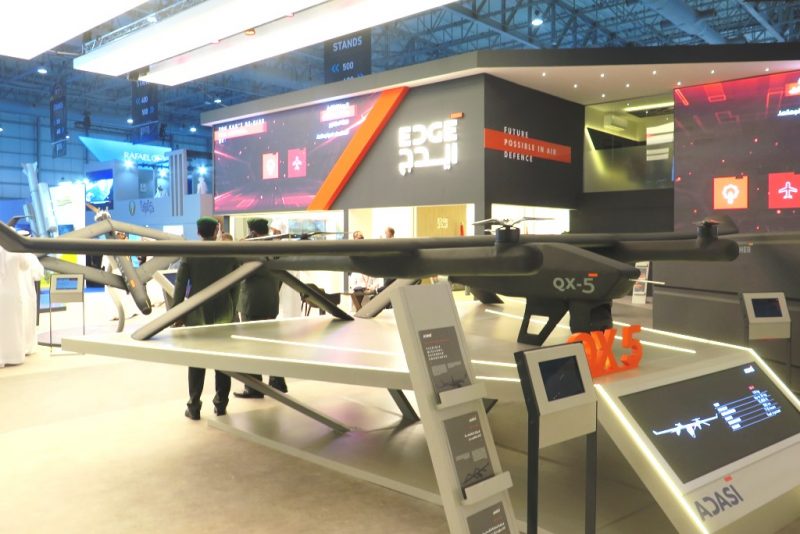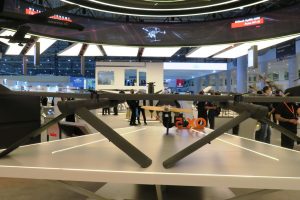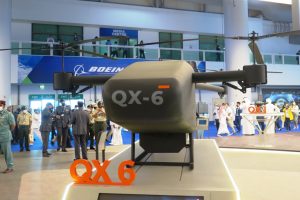Dubai Airshow: Edge unveils its new UAVs
By Joseph Roukoz
The Edge Group, the UAE defence technology group that regroups most of the Emirates players involved in high-tech and military production, unveiled at the Dubai Airshow two more members of its QX family of UAVs, the previous having been shown for the first time at IDEX last February.
With QX numbering from 1 to 4 shown at the Abu Dhabi exhibition, it was the turn of QX-5 and QX-6 to be unveiled in Dubai.
The QX-5 architecture is partly similar to that of the QX-4 loitering munition, but the drone is much bigger and is aimed at ISR (Intelligence, Surveillance, Reconnaissance) missions. A fixed wing aircraft with central fuselage and twin booms, each with an inverted-V tail, the QX-5 has a hybrid powerplant.
The main propulsion is provided by a fuel-injected piston engine located at the rear of the short fuselage, which drives a two-blade propeller, the optronic package being at the front of the fuselage, which allows bringing the centre of gravity at the wing level. The engine drives a starter/generator that ensures the power needed by the four electric motors driving the four rotors, which are located at the front and rear of each boom, and ensure vertical take-off and landing. When in horizontal flight the QX-5 relies on the combustion engine and the pushing propeller, aerodynamic flight being obviously much less power-hungry and allowing a 15,000 feet operational ceiling. The QX-5 is fitted with an advanced autopilot and a data link that allows it to operate at 100 km from the ground control station. The QX-5 is proposed for military missions, as well as for border control and surveillance. The new drone is under development by ADASI, part of the Edge Group, the company planning the first flight of the prototype in the coming months.
The QX-6 is a much bigger aircraft, meant for cargo transport in a wholly autonomous manner. It has a massive fuselage with four short wings, two at the front and two at the rear, carrying each one three-blade rotor. Not many details were provided on propulsion, but the combustion engine should be used as power generator for the four electric motors that drive the rotors. A cargo bay is located under the fuselage, a pod allowing automatic delivery of the payload, both on land or at sea, the QX-6 being designed also for operating on seagoing vessels, as well of course as on land, especially in hard to access locations or in dangerous situations. The maximum take-off weight is 500 kg, for a 150 kg payload; as an example, considering that a loaded 30-round 5.56 mm magazine weighs short of 0.5 kg, one rotation of QX-6 could bring in up to 300 magazines to a unit which is low on ammunition. The QX-6 is fitted with an on-board video for monitoring the operation, but EDR On-Line understood that ADASI aims at full autonomy. The QX-6 has a 100 km range and an endurance that varies from 1 to 4 hours, depending on payload, operational ceiling being 10,000 feet.
Photos by J. Roukoz




